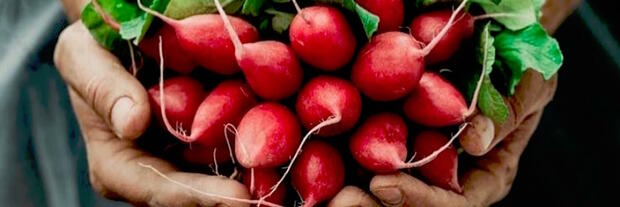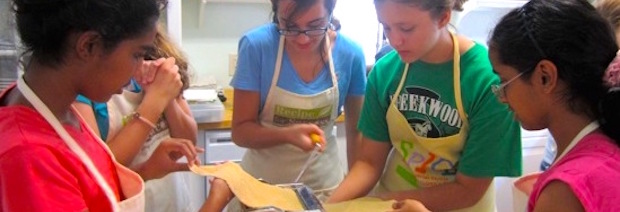According to a recent article on Preventobesity.net, a new report reveals that buying fresh produce from the grocery store is easier on your wallet than you might think.. Following the story in it's entirety:
"But it's too expensive." Those four words are perhaps the most common excuse people give when explaining why they don't eat more fruits and vegetables. Sure, produce is healthy, but people argue it's just too pricey.
Fair enough -- except that this assumption is totally wrong. So long as you have access to a grocery store, anyway.
A new study commissioned by the Produce Marketing Association (PMA) has discovered that fresh fruits and veggies are shockingly reasonable, even inexpensive, compared to other common grocery store items. Nine servings of produce, the recommended daily amount according to government guidelines, cost a total of only $2.18 on average.
"We kept hearing, 'It's too expensive, it's too expensive," says Kathy Means, PMA's vice president of government relations and public affairs. "We knew that wasn't true, but we couldn't prove it. That's why we invested in the research."
Researchers also found that bargain hunters -- those folks known to clip coupons or only buy things on sale -- could nab nine servings of fruits and veggies for as low as 88 cents a day.
"It's really a bargain basement price. We think it's more of a value meal than a value meal," Means tells the Inside Track. "Even at $2.18, when you think what a bag of chips costs, you're talking about a lot of good, tummy-filling stuff compared to a bag of chips."
The report only looks at produce prices at grocery stores. People who live in food deserts -- communities without close access to a supermarket -- still face hurdles in finding affordable produce. For example, a 2009 study by the U.S. Department of Agriculture found that people who live in food deserts typically shop at corner markets, which often lack fresh foods and maintain prices that are higher than supermarkets.
In this respect, the report underscores the importance of bringing supermarkets to these under-served communities. Easier access to grocery stores will mean easier access to affordable fresh fruits and vegetables.
Undertaken by The Perishables Group, the report looked at point-of-sale data for all fruits and vegetables at grocery stores over a year. Researchers only considered fresh items that people would eat as a serving. For instance, garlic, which is typically used as a seasoning, was among the items that didn't make the cut. When creating serving sizes, researchers left out the non-edible parts, like apple cores.
The team found that the average cost for a serving of fruit is 28 cents, while a serving of veggies costs 21 cents. That includes items marked at full price, as shopping sales or seasonal purchases tend to lead to big discounts.
Produce prices tend to be cheapest in the fourth quarter of the year, but don't really fluctuate that much year-round. The high was an average of $2.31 for nine servings in the second quarter of the year, compared to the low of $2.08 in the fourth. Prices between regions also are relatively consistent, as the lowest cost for nine servings averaged about $2.08 in the east, compared to $2.30 in the south, which had the highest totals.
But those statistics include some full price items. With a little research and planning, shoppers can save as much as 60 percent off their produce bill. "This is a remarkably low cost when compared to the cost per serving for most processed foods, fast food restaurants and even vending machine snacks," the report reads.
So why does the produce-is-expensive myth continue? Part of the issue is that the produce industry needs to do a better job explaining to customers how affordable it is to buy fresh produce, Means says. She points out that even first lady Michelle Obama, who has promoted fresh fruits and veggies as part of her Let's Move! Campaign, has said produce is more expensive than other goods.
"People think, 'well, if I buy a grapefruit, that's kind of expensive," Means says. "But a grapefruit might have three servings in it."
Means and others are aiming to spread the word that there's now quantitative proof that produce is more affordable than most people realize. "We knew produce was less expensive than people thought, but we didn't know it was this inexpensive," she says.####
We know that at Recipe for Success, where we manage to feed 3,000 kids a meal they help prepare from principally from fresh produce at a food cost of less than 50 cents each.
"But it's too expensive." Those four words are perhaps the most common excuse people give when explaining why they don't eat more fruits and vegetables. Sure, produce is healthy, but people argue it's just too pricey.
Fair enough -- except that this assumption is totally wrong. So long as you have access to a grocery store, anyway.
A new study commissioned by the Produce Marketing Association (PMA) has discovered that fresh fruits and veggies are shockingly reasonable, even inexpensive, compared to other common grocery store items. Nine servings of produce, the recommended daily amount according to government guidelines, cost a total of only $2.18 on average.
"We kept hearing, 'It's too expensive, it's too expensive," says Kathy Means, PMA's vice president of government relations and public affairs. "We knew that wasn't true, but we couldn't prove it. That's why we invested in the research."
Researchers also found that bargain hunters -- those folks known to clip coupons or only buy things on sale -- could nab nine servings of fruits and veggies for as low as 88 cents a day.
"It's really a bargain basement price. We think it's more of a value meal than a value meal," Means tells the Inside Track. "Even at $2.18, when you think what a bag of chips costs, you're talking about a lot of good, tummy-filling stuff compared to a bag of chips."
The report only looks at produce prices at grocery stores. People who live in food deserts -- communities without close access to a supermarket -- still face hurdles in finding affordable produce. For example, a 2009 study by the U.S. Department of Agriculture found that people who live in food deserts typically shop at corner markets, which often lack fresh foods and maintain prices that are higher than supermarkets.
In this respect, the report underscores the importance of bringing supermarkets to these under-served communities. Easier access to grocery stores will mean easier access to affordable fresh fruits and vegetables.
Undertaken by The Perishables Group, the report looked at point-of-sale data for all fruits and vegetables at grocery stores over a year. Researchers only considered fresh items that people would eat as a serving. For instance, garlic, which is typically used as a seasoning, was among the items that didn't make the cut. When creating serving sizes, researchers left out the non-edible parts, like apple cores.
The team found that the average cost for a serving of fruit is 28 cents, while a serving of veggies costs 21 cents. That includes items marked at full price, as shopping sales or seasonal purchases tend to lead to big discounts.
Produce prices tend to be cheapest in the fourth quarter of the year, but don't really fluctuate that much year-round. The high was an average of $2.31 for nine servings in the second quarter of the year, compared to the low of $2.08 in the fourth. Prices between regions also are relatively consistent, as the lowest cost for nine servings averaged about $2.08 in the east, compared to $2.30 in the south, which had the highest totals.
But those statistics include some full price items. With a little research and planning, shoppers can save as much as 60 percent off their produce bill. "This is a remarkably low cost when compared to the cost per serving for most processed foods, fast food restaurants and even vending machine snacks," the report reads.
So why does the produce-is-expensive myth continue? Part of the issue is that the produce industry needs to do a better job explaining to customers how affordable it is to buy fresh produce, Means says. She points out that even first lady Michelle Obama, who has promoted fresh fruits and veggies as part of her Let's Move! Campaign, has said produce is more expensive than other goods.
"People think, 'well, if I buy a grapefruit, that's kind of expensive," Means says. "But a grapefruit might have three servings in it."
Means and others are aiming to spread the word that there's now quantitative proof that produce is more affordable than most people realize. "We knew produce was less expensive than people thought, but we didn't know it was this inexpensive," she says.####
We know that at Recipe for Success, where we manage to feed 3,000 kids a meal they help prepare from principally from fresh produce at a food cost of less than 50 cents each.














Have a question?